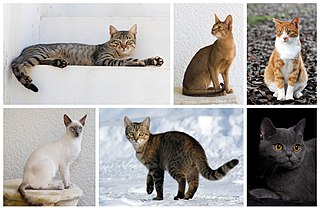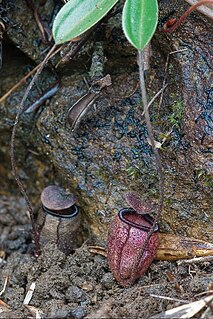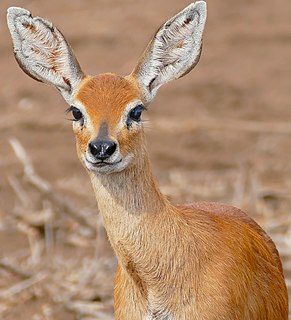
The cat is a domestic species of small carnivorous mammal. It is the only domesticated species in the family Felidae and is often referred to as the domestic cat to distinguish it from the wild members of the family. A cat can either be a house cat, a farm cat or a feral cat; the latter ranges freely and avoids human contact. Domestic cats are valued by humans for companionship and their ability to hunt rodents. About 60 cat breeds are recognized by various cat registries.

Ecology is the study of the relationships between living organisms, including humans, and their physical environment, . Ecology considers organisms at the individual, population, community, ecosystems, and biosphere level. Ecology overlaps with the closely related sciences of biogeography, evolutionary biology, genetics, ethology and natural history. Ecology is a branch of knowledge, and it is not synonymous with environmentalism.

A primate is a eutherian mammal constituting the taxonomic order Primates. Primates arose 85–55 million years ago first from small terrestrial mammals, which adapted to living in the trees of tropical forests: many primate characteristics represent adaptations to life in this challenging environment, including large brains, visual acuity, color vision, a shoulder girdle allowing a large degree of movement in the shoulder joint, and dextrous hands. Primates range in size from Madame Berthe's mouse lemur, which weighs 30 g (1 oz), to the eastern gorilla, weighing over 200 kg (440 lb). There are 190–448 species of living primates, depending on which classification is used. New primate species continue to be discovered: over 25 species were described in the 2000s, and 11 since 2010.

Krill are small crustaceans of the order Euphausiacea, and are found in all the world's oceans. The name "krill" comes from the Norwegian word krill, meaning "small fry of fish", which is also often attributed to species of fish.

Homo is the genus that emerged in the genus Australopithecus that encompasses the extant species Homo sapiens, plus several extinct species classified as either ancestral to or closely related to modern humans, most notably Homo erectus and Homo neanderthalensis. The genus emerged with the appearance of Homo habilis just over 2 million years ago. Homo, together with the genus Paranthropus, is probably sister to Australopithecus africanus, which itself had previously split from the lineage of Pan, the chimpanzees.

Mountain coatis are two species of procyonid mammals from the genus Nasuella. Unlike the larger coatis from the genus Nasua, mountain coatis only weigh 1.0–1.5 kilograms (2.2–3.3 lb) and are endemic to the north Andean highlands in South America.
The Thermotogae are a phylum of the domain Bacteria. The phylum Thermotogae is composed of Gram-negative staining, anaerobic, and mostly thermophilic and hyperthermophilic bacteria.

Nepenthes truncata is a tropical pitcher plant endemic to the Philippines. It is known from the islands of Dinagat, Leyte, and Mindanao. The species grows at an elevation of 0–1500 m above sea level. Nepenthes truncata is characterised by its heart-shaped (truncate) leaves and very large pitchers, which can reach up to 40 cm in height.

Nepenthes argentii is a highland Nepenthes pitcher plant native to Mount Guiting-Guiting on Sibuyan Island in the Philippines. It is possibly the smallest species in the genus and does not appear to have a climbing stage.

Johnston's genet is a genet species native to the Upper Guinean forests. As it is threatened by deforestation and conversion of rainforest to agriculturally and industrially used land, it is listed as Near Threatened on the IUCN Red List.

Raphicerus is a genus of small antelopes of the tribe Neotragini.

Schistura is a genus of fish in the stone loach family Nemacheilidae native to the streams and rivers of the southern and eastern Asia. Some of these species are troglobitic.
Erich Martin Hering was a German entomologist who specialised in leafmining insects, He was a curator in the Museum für Naturkunde in Berlin, where his collections of Lepidoptera, Coleoptera, Hymenoptera, Diptera are conserved. His collections of Agromyzidae are shared between MfN and the Agricultural School at Portici now part of the University of Naples Federico II.
In biology, a species is the basic unit of classification and a taxonomic rank of an organism, as well as a unit of biodiversity. A species is often defined as the largest group of organisms in which any two individuals of the appropriate sexes or mating types can produce fertile offspring, typically by sexual reproduction. Other ways of defining species include their karyotype, DNA sequence, morphology, behaviour or ecological niche. In addition, paleontologists use the concept of the chronospecies since fossil reproduction cannot be examined.

Bats are mammals of the order Chiroptera. With their forelimbs adapted as wings, they are the only mammals capable of true and sustained flight. Bats are more manoeuvrable than birds, flying with their very long spread-out digits covered with a thin membrane or patagium. The smallest bat, and arguably the smallest extant mammal, is Kitti's hog-nosed bat, which is 29–34 millimetres in length, 150 mm (6 in) across the wings and 2–2.6 g in mass. The largest bats are the flying foxes, with the giant golden-crowned flying fox, Acerodon jubatus, reaching a weight of 1.6 kg and having a wingspan of 1.7 m.
Nitrospirae is a phylum of bacteria. It contains only one class, Nitrospira, which itself contains one order (Nitrospirales) and one family (Nitrospiraceae). It includes multiple genera, such as Nitrospira, the largest. The first member of this phylum, Nitrospira marina, was discovered in 1985. The second member, Nitrospira moscoviensis, was discovered in 1995.

The World's 25 Most Endangered Primates is a list of highly endangered primate species selected and published by the International Union for Conservation of Nature Species Survival Commission Primate Specialist Group, the International Primatological Society (IPS), and Conservation International (CI). The 2012–2014 list added the Bristol Conservation and Science Foundation (BCSF) to the list of publishers. The IUCN/SSC PSG worked with CI to start the list in 2000, but in 2002, during the 19th Congress of the International Primatological Society, primatologists reviewed and debated the list, resulting in the 2002–2004 revision and the endorsement of the IPS. The publication has since been a joint project between the three conservation organizations and has been revised every two years following the biannual Congress of the IPS. Starting with the 2004–2006 report, the title changed to "Primates in Peril: The World's 25 Most Endangered Primates". That same year, the list began to provide information about each species, including their conservation status and the threats they face in the wild. The species text is written in collaboration with experts from the field, with 60 people contributing to the 2006–2008 report and 85 people contributing to the 2008–2010 report. The 2004–2006 and 2006–2008 reports were published in the IUCN/SSC PSG journal Primate Conservation, while the 2008–2010 and 2010-2012 report were published as independent publications by all three contributing organizations.
Hyocephalidae are a small family of Heteroptera which are endemic to Australia.
Alfred Frank Millidge was a British arachnologist who wrote several works on spiders. One of his best-known might be British Spiders, volumes I and II, which he co-wrote with G. H. Locket. In 1983, he became the first person to describe the spider species Walckenaeria crocea.












